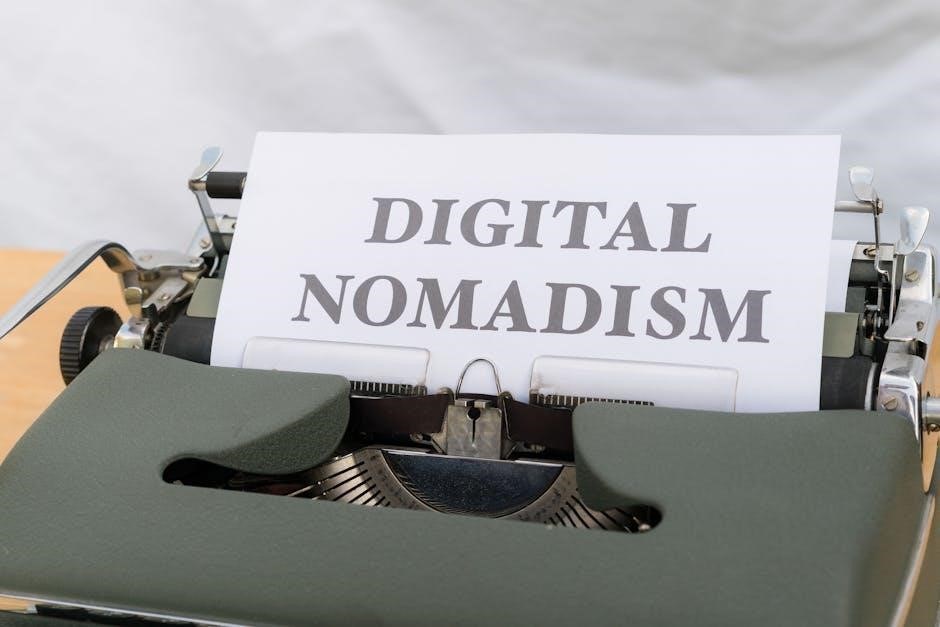A recommendation letter is a written endorsement highlighting an individual’s skills, achievements, and character, often used in professional or academic contexts to support applications.
1.1 Definition and Purpose
A recommendation letter for a coworker is a written and signed document that provides feedback on an individual’s performance, leadership, and work ethic. It is typically written by a colleague or supervisor to support applications for new positions, graduate programs, or other opportunities. The letter highlights the individual’s skills, character, and contributions, serving as a professional endorsement to help advance their career.
1.2 Importance in Professional Contexts
A recommendation letter for a coworker holds significant value in professional settings, serving as a credible endorsement of their skills, character, and work ethic. It provides insights into their performance and contributions, aiding employers or academic admissions committees in assessing candidates. A well-crafted letter can enhance career opportunities, differentiate candidates in competitive environments, and reinforce trust in their abilities. Personalized and detailed recommendations make a stronger impact, showcasing the individual’s potential for future success.
Structure of a Recommendation Letter
A recommendation letter typically includes sender’s contact info, date, greeting, introduction, body detailing qualifications, and a closing with a signature and contact details.
2.1 Standard Format
A recommendation letter typically begins with the sender’s contact information, followed by the date and recipient’s address. The body includes an introduction, details about the individual’s qualifications, and a closing statement. It is often written in formal language and structured in a professional tone. Templates are widely available in formats like PDF and Word, allowing users to customize content while maintaining a polished appearance. This ensures clarity and effectiveness in presenting the recommendation.
2.2 Key Components
A recommendation letter for a coworker should include the sender’s contact information, date, recipient’s address, and a formal greeting. The body must detail the coworker’s skills, achievements, and contributions, supported by specific examples. It should also express confidence in their abilities and suitability for the opportunity. A professional closing, including a signature and contact details, completes the letter. Using a PDF template ensures consistency and a polished appearance, making the recommendation clear and impactful.
Writing Tips
Use clear and sincere language, highlighting your coworker’s strengths and achievements. Customize the PDF template to ensure professionalism and personalization, making the recommendation impactful and credible.
3.1 Choosing the Right Tone
When crafting a recommendation letter for a coworker, it’s essential to strike a balance between professionalism and sincerity. Use a formal yet warm tone to convey genuine enthusiasm and confidence in your coworker’s abilities. Avoid overly casual language, as it may undermine the letter’s credibility. Instead, focus on clear, concise statements that highlight their strengths and qualifications. This approach ensures the letter is both respectful and persuasive, making it more impactful for the recipient.
3.2 Highlighting Key Qualities
When highlighting key qualities in a recommendation letter for a coworker, emphasize their professional skills, work ethic, and contributions to the team. Mention specific achievements, such as successful projects or leadership roles, to provide concrete examples of their capabilities. Additionally, highlight soft skills like communication, collaboration, and problem-solving, which are crucial in a team-oriented environment. This focused approach ensures the letter effectively showcases their strengths and suitability for future opportunities.
Templates and Samples
Downloadable PDF templates and samples for recommendation letters are widely available online, offering customizable formats in Word, Google Docs, and Apple Pages for professional endorsement.
4.1 Overview of PDF Templates
PDF templates for recommendation letters offer structured, professional designs, making it easy to draft endorsements for coworkers. These templates are customizable, allowing users to input specific details like job roles, achievements, and personal qualities. They are compatible with various formats, including Word, Google Docs, and Apple Pages, ensuring versatility. Many websites provide free downloads, catering to different scenarios, such as employment or academic recommendations, and are easily editable to suit individual needs.
4.2 Where to Find Templates
Discover professional PDF templates for recommendation letters on platforms like Canva, Microsoft Word, and Google Docs. Websites such as Template.net and PDFTemplates.com also offer a variety of customizable options; LinkedIn and other professional networking sites provide resources and examples tailored for career development. Ensure the template is adaptable to your needs, with placeholders for specific details, and compatible with formats like Word for easy editing. Opt for templates that are free or reasonably priced, ensuring a professional and polished final document in PDF format.

Examples
Explore sample recommendation letters for various scenarios, such as employment or academic applications, to understand effective structures and language for endorsing colleagues professionally.
5.1 Sample Letters for Different Scenarios
Sample letters for coworkers are available for various scenarios, such as employment, academic applications, or graduate school. These templates provide structured formats to endorse colleagues professionally. For instance, a recommendation letter for a coworker pursuing graduate school highlights their skills and contributions. Downloadable PDF and Word templates offer customizable options, ensuring personalized endorsements. These examples demonstrate effective language and tone, making it easier to craft compelling recommendations tailored to specific situations and recipients.
5.2 Analyzing a Strong Recommendation Letter
A strong recommendation letter for a coworker is clear, specific, and professional. It highlights key skills, achievements, and personal qualities, supported by examples. The tone is enthusiastic yet sincere, demonstrating genuine endorsement. Effective letters are tailored to the recipient’s needs, whether for employment, education, or residency programs. They emphasize the coworker’s contributions, reliability, and potential, ensuring a compelling and credible endorsement that stands out to reviewers.

Best Practices
Always personalize the letter, highlighting specific skills and contributions. Maintain a professional tone, be sincere, and include concrete examples to enhance credibility and impact.
6.1 Dos and Don’ts
When crafting a recommendation letter for a coworker, ensure it is personalized and specific. Use professional language and avoid generic statements. Highlight key qualities, skills, and contributions. Include concrete examples to support your endorsement. Avoid bias, exaggerations, or unprofessional tone. Keep the letter concise but detailed, ensuring it reflects the individual’s strengths accurately. Use templates as a guide but tailor the content to the specific context and relationship.
6.2 Common Mistakes to Avoid
Avoid vague statements and ensure the letter is specific to the coworker’s role and achievements. Refrain from exaggerating their abilities or taking credit for their work. Do not include confidential or sensitive information. Avoid using overly casual language or jargon. Ensure proper formatting and proofread for errors. Never submit a template without personalizing it for the individual and the specific opportunity they are pursuing.

Legal and Ethical Considerations
Ensure confidentiality by avoiding sensitive information. Maintain honesty and accuracy to avoid legal issues. Avoid bias and discrimination, adhering to ethical standards. Always respect privacy and professionalism.
7.1 Confidentiality
Confidentiality is crucial in recommendation letters. Ensure personal and sensitive information about the coworker is not disclosed. Access should be restricted to authorized parties only. Maintain privacy by avoiding unauthorized sharing. Use secure methods for transmission. Adhere to data protection laws to prevent breaches. Protect the individual’s reputation and trust by handling the letter discreetly. Always confirm the purpose before sharing the document. Safeguarding confidentiality builds trust and professionalism.
7.2 Avoiding Bias
Avoiding bias in recommendation letters ensures fairness and equal opportunity. Focus on the coworker’s qualifications, skills, and achievements. Use specific examples to support claims, avoiding stereotypes or assumptions. Ensure language is neutral and free from discrimination based on gender, race, or other personal characteristics. Highlight contributions objectively, fostering an inclusive environment. Bias-free recommendations promote merit-based evaluations, ensuring the coworker is judged solely on their abilities and performance. Maintain professionalism and equity in your endorsement.

Digital Formatting
Digital formatting ensures clarity and professionalism. Use clear fonts, proper spacing, and a consistent layout. Save as PDF for a polished, visually appealing recommendation letter.
8.1 PDF vs. Word
When formatting a recommendation letter, choosing between PDF and Word depends on the context. PDFs are preferred for their professional appearance and consistency across devices, ensuring the letter looks polished and formatted correctly. Word documents, however, allow for easy editing and customization, making them ideal for drafting and revising. For final submissions, PDF is recommended to maintain a professional and permanent record of the letter.
8.2 Significance of PDF
PDFs are widely preferred for recommendation letters due to their professional appearance and consistency across devices. They ensure the letter’s formatting remains intact, maintaining a polished look. PDFs are also secure, preventing unintended edits, and are easily shareable. For formal documents like recommendation letters, PDFs are ideal as they convey credibility and permanence, making them the standard choice for professional and academic submissions. This format is universally accepted and trusted.
Tools and Resources
Professional tools like Canva and Adobe Acrobat offer customizable PDF templates. Google Docs and Microsoft Word provide additional resources, ensuring polished and professional recommendation letters.
9.1 Software for Creating Letters
Software like Canva, Google Docs, and Microsoft Word offer intuitive tools for crafting recommendation letters. Canva provides visually appealing templates, while Google Docs and Word enable easy editing and formatting. Adobe Acrobat is ideal for creating and editing PDFs, ensuring professional presentation. These platforms streamline the process, allowing users to customize templates efficiently and produce polished, professional recommendation letters for coworkers.
9.2 Online Generators
Online generators like Canva and LetterBuilder provide pre-designed templates for recommendation letters, making it easy to create professional documents. These tools often feature drag-and-drop interfaces, customizable fields, and ready-to-use phrases. Users can input specific details about their coworker, such as skills and contributions, and generate a polished letter instantly. Many platforms also allow direct PDF downloads, ensuring a professional finish without the need for advanced design skills.
A well-crafted recommendation letter for a coworker, using PDF templates, effectively endorses their skills and character, making it easier for them to advance in their career.
10.1 Summary of Key Points
A recommendation letter for a coworker in PDF format is a professional endorsement of their skills, contributions, and character. Using customizable templates ensures consistency and clarity. Emphasize specific achievements and qualities to make the letter impactful; PDFs are ideal for maintaining a professional presentation and are widely accepted. Always tailor the letter to the recipient and purpose, ensuring it reflects the coworker’s strengths and your confidence in their abilities. This creates a credible and supportive document for their career advancement.
10.2 Final Tips
Always use professional templates for consistency and clarity. Personalize the letter to highlight your coworker’s unique strengths and achievements. Proofread thoroughly to ensure error-free content. Opt for PDF formats to maintain a polished and professional appearance. Tailor the tone to match the recipient’s expectations. Be sincere and specific to make the recommendation impactful and credible, ensuring it supports your coworker’s career advancement effectively.